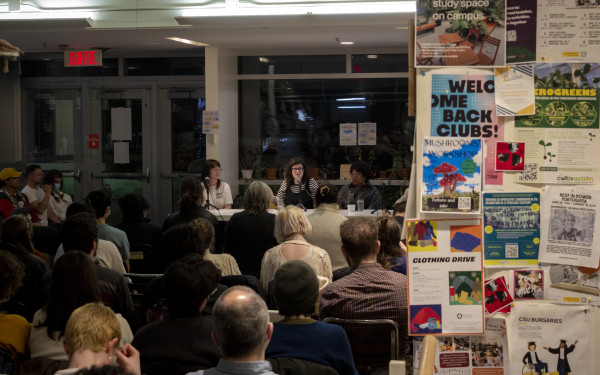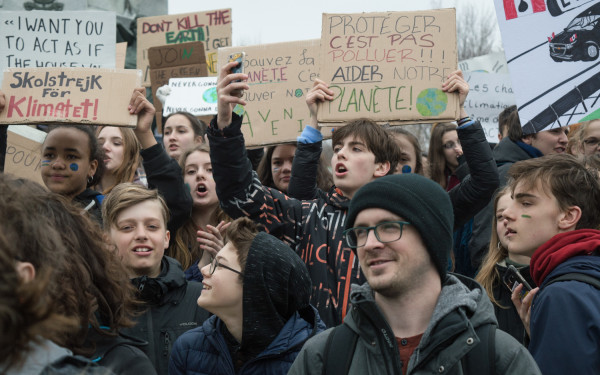Recognizing Eco-Fascist Rhetoric
How Fascist Ideology Is Infiltrating Environmentalist Movements
If fascists were hijacking environmental movements, that would be important to know and recognize.
In my notes, I found transcriptions from a workshop on eco-fascism at Concordia’s Le Frigo Vert, from way back on Oct. 25.
For a while, I had forgotten what I learned in the workshop and went about my busy life, until I recently saw a Facebook post about overpopulation that didn’t sit right.
Sure enough, in the comments, it was obvious this post incited disgust about the third world and “overpopulation,” some even going as far as to insinuate sterilization was a solution.
Sometimes, terms and topics like overpopulation are a dog-whistle, where it becomes obvious beneath the surface that the concern is not about overpopulation but about certain populations.
The event aimed to convey the importance of rejecting eco-fascist rhetoric and recognizing it as it finds its way into mainstream and leftist environmental movements.
What is eco-fascism?
Eco-fascism refers to fascist ideas appearing in environmentalist social movements and ideology.
Fascism not only appears in some environmentalist movements, fascists have also incorporated ecology into their ideas.
Not only liberals and leftists care for the environment. In fact, many fascists, far-rightists, and even Nazis have ecology on their minds.
I will refer to a glossary received at the event to explain terms like deep ecology, described as both a social movement and environmental philosophy.
This ideology has mystical undertones and differentiates itself from other types of environmentalism by making both broad and basic philosophical claims.
While deep ecology is embraced by a variety of other social movements, one of its pillars—that the decrease of the human population would be necessary to preserve the environment—appeals particularly to fascists.
This idea can be found in the mainstream, but it can often be a dog-whistle for fascist and racist ideas regarding whose population needs to be controlled and who the environment should be preserved for.
The above can also provide a semblance of legitimacy for the underlying desires of people who believe in eugenics, getting rid of certain groups of people by sterilizing them.
These ideas can exist instead of or in addition to those who want to get rid of entire groups of people through explicit genocide.
To be clear, limiting a population or demographic by sterilization is a form of genocide—just one that can appear more palatable to some because it’s less explicit and might distance the perpetrators from the result more effectively.
While the idea of overpopulation existing is not in itself racist, eugenicist, or genocidal, the idea of population control or the enforcement of population-curbing measures that may be suggested or inferred by this are.
It might appear palatable to the mainstream, but this could be a gateway to thought patterns like that of the El Paso shooter, who mentioned in his manifesto that we are too many with too few resources to share, implying his Aug. 3, 2019 massacre, largely of non-white folks, was a contribution to a such solution.
This same shooter also described immigration and refugee movement to the United States as an invasion, and terms such as “invasion” or “infestation” are often used to advance the implication of one type of person being seen as lesser.
The El Paso shooter dropped many lines in his manifesto about the environment alongside his racist tirade, advocating for preserving the environment, but for Americans, and with that his racist ideas of what “American” means.
Deep ecology can take many forms, and while it is embraced by a variety of social movements, one of its pillars appeals particularly to fascists: decreasing the human population would be necessary to preserve the environment.
This idea can be found in mainstream climate discussions, but can also be a dogwhistle for fascist and racist ideas regarding whose population needs to be controlled, and who the environment should be preserved for.
Images shown in the presentation, originating from eco-fascist sources, showed many arguments of overpopulation in connection with a “solution,” which can range from response memes of nuking specific places where populations are too high or preventing their reproduction through a number of other grisly suggestions.
While the idea of overpopulation is not in itself racist, eugenicist, or genocidal, the idea of population control or the enforcement of population-curbing measures that may be suggested or inferred by this often are.
Where does the “eco” meet the fascism?
Thomas Malthus, who was among a long list of philosophers cited as inspiring the eco-fascists of today, argued the nature of man is selfish, raised the issues of overpopulation and scarcity of resources, and brutally stated that feeding the poor would cause them to continue to procreate and exacerbate the situation.
Instead of identifying inequality as the problem, inequality was seen as the natural hierarchy of things.
Eco-fascist groups online today often blame overpopulation, mostly in the global south, for climate change.
This could lead some to subscribe to pro-eugenics arguments rather than focus on other, more salient causes of climate change or speak out against inequality, to demand a more equitable distribution of resources and better access to education.
Madison Grant wrote the book Adolf Hitler referred to as his bible, made early arguments of replacement theory, particularly about Nordic people, and has been referred to as the father of eco-fascism.
Grant has been referred to as the father of eco-fascism.
The same regime also heavily believed in eugenics and ridding their society of what was not seen as perfect, all the while advocating for the health and wellbeing of the people they wanted to see more of.
Nazis themselves had green politics, including land reform, co-ops, emphasis on small and local farmers, anti-capitalist and anti-bourgeois views.
It is important to note that “anti-bourgeois” had serious anti-semitic undertones in this case.
The Nazis also believed in eugenics and ridding society of what was not seen as perfect, all the while advocating for the health and well-being of the people they wanted to see more of.
Italian fascist Evola, who argued for the superiority of western civilization, which we still hear today from the far-right, as well as arguments about natural inequalities, and Hardin who advanced the idea of lifeboat ethics and wrote Tragedy of the Commons are still oft-cited thinkers who influence today’s eco-fascists.
For more modern thinkers, deep-ecologist and eco-fascist writer Pentti Linkola can be one of the most revealing sources for some of the pillars of today’s eco-fascist.
Linkola suggested there ought to be licenses to allow only certain people to give birth. He advocated for dictators because modern democracy is flawed.
He also wrote of a hypothetical lifeboat. “When the lifeboat is full, those who hate life will try to load it with more people and sink the lot. Those who love and respect life will take the ship’s axe and sever the extra hands that cling to the sides.”
I think back and am able to point out moments where I’ve seen arguments like this—many on posts about refugees arriving in Europe.
Eco-fascism, here and now
Not all eco-fascists are aware of the origins of the philosophy or are well read on it, but they may still buy the rhetoric from word of mouth, organized groups, and memes.
One might see imagery and slogans from eco-fascist sources being unwittingly shared on social media and a particular type of meme or image called “fashwave.”
The speakers showed memes that might appeal to the ordinary individual and appear on pages that seem leftist or liberal-environmentalist, but with alarming undertones that infiltrate the mainstream.
A dead giveaway is often Nordic runes, which are symbols the alt-right or eco-fascists use in their memes and imagery, such as the “life rune,” which looks like the centre of the peace sign with the forks upward like a tree.
Nazis or eco-fascists generally use rune imagery to call upon Viking or Aryan sentiments and it is known by anti-fascists as a hate symbol used by white supremacists.
This runic imagery appears in fashwave and eco-fascist imagery.
*Why does this matter in Quebec and Canada? *
According to organizer Shevaughn, who only provided a first name for privacy reasons, these movements are gaining steam and riding on nationalism and fascist identity issues long present in our society.
“When we look elsewhere at eco-fascism, we see elements of that coming into groups here,” said Shevaughn. “Right now we see the CAQ, and one of the first things they did was bring in Bill 21.”
Since, the CAQ has made even more changes that encourage racism, including the whole confusion surrounding immigration reforms and, more recently, changes to education curriculum to stop Ethics and Religious Culture (basically anthropology classes) from being taught in high schools.
Despite plans to replace the course with classes covering civics issues and other topics, the move might effectively encourage ignorance and create more instances of racism borne from such ignorance, which has seen Sikhs and Muslims become the target of hateful assaults.
A focus on civic duty over diversity would not challenge the ethno-nationalism being popularised. For evidence of this, please feel free to check the comment section of any news publications which touch upon minority groups.
“During the election, [there were] groups meeting at the border to let the government know they want to see the closure of Roxham Rd. There’s this idea of needing to take care of ‘our own’ before—‘les notres avant les autres,’” Shevaughn had told me.
There is ample evidence to suggest that the workforce needs new immigrants. Refugees and immigration end up being good for the economy in the long term, despite opposition to accepting immigrants and refugees.
“We have the resources to take care of everyone,” said Shevaughn. “They’re just being misused. A lot of it is people being misinformed, and there’s no basis to some of these narratives.”
It’s also claimed that immigrants or refugees can add to the issue of overpopulation, which is not a salient issue in Canada.
“Overpopulation always means, within eco-fascism, less immigrants and less People of Colour,” said organizer Alan Wong.
“It’s [the idea that it’s] white people that have the right to exist in the world. What about industry, what about capitalism?” Wong said.
“Those are the things that are destroying the environment, not immigration.”
The speakers revealed that fascist political parties and social movements have recently gained some popularity in Quebec, even using eco-fascist ideas that might appeal to people.
Atalante, a far right organization based in Quebec City, frequently uses nature imagery to promote itself and its neo-fascist ideals, borrowing some ideas and imagery from European neo-fascist groups like CasaPound and Italian fascist philosopher Evola.
On links to Indigenous issues, it was also raised that far-right Quebec nationalists have attempted to rewrite history by painting a portrait of some kind of harmony between First Nations and early settlers from France, by claiming Métis heritage, and implying that the “real” colonization was the British period.
It is impossible to omit colonialism from the discussion on eco-fascism.
The ideas behind eco-fascism rely on a sense of belonging to the land and the land belonging to “our people,” which erases Indigenous people.
The speakers explained how, to justify the takeover of the land, ideas of “manifest destiny” where the settler is “destined” to inhabit and own the land, in addition to both forced assimilation and genocide, are employed to legitimize the settler population.
Now, descendants of those settlers can make claims about preserving the land in the name of nationalism, erasing Indigenous land claims in its revisionism.
This is coherent with patterns of nationalists painting a great and glorious past when trying to justify settler-colonial violence, rhetoric often seen from Quebec nationalists or the far-right.
According to the event organizers, eco-fascism is arguably white-centred and synonymous with Indigenous erasure, implying that First Nations people are not the rightful custodians of their lands.


_600_832_s.png)


_600_375_90_s_c1.jpg)

